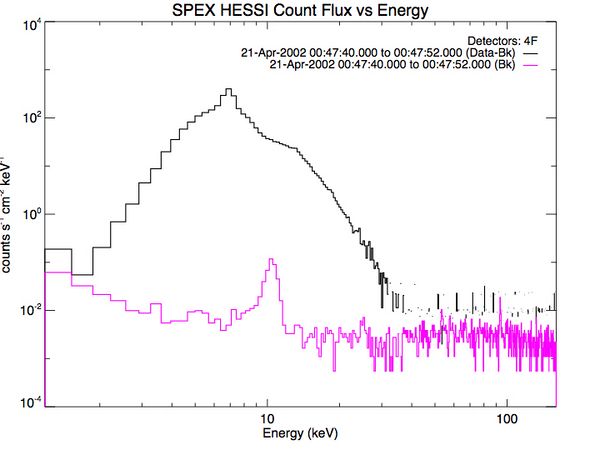Pileup mod - Pseudo function for correcting pileup
From RHESSI Wiki
Contents |
Pileup Correction Component
Introduction
pileup_mod attempts to correct for photons which lose energy in the detector at the same time (within 1 microsecond of each other). Photons that arrive within the 1 µs are counted as a single event with the energy of the photons summed. During high countrate time intervals of a flare this detector effect can distort the spectrum. This fit component attempts to fit pileup effects during these intervals, this allows a more accurate measure of physical parameters such as the Emission Measure and Temperature.
Parameters
pileup_mod - always returns a value of 0. Parameters are varied during fit and used in apply_drm method to add pileup effects to model on the fly.
- a[0] - coefficient to increase or decrease probability of pileup for energies > cutoff
- a[1] - average fractional energy from piled up photon
- a[2] - smoothing parameter in keV (sigma)
- a[3] - cutoff energy in keV that defines two regions
- a[4] - effectiveness ratio for pileup for energy loss less than cutoff energy
- a[5] - sine-modulated fraction of flux
Synopsis
Pileup causes a distortion of the RHESSI spectrum during high countrate time intervals of an event. RHESSI Spectra have a low energy peak. During high countrate time intervals it becomes likely that any two photons losing energy in the detector within 1µs will have the energy of a photon around the peak of the spectrum. This leads to a shoulder in the spectrum at around twice the value (in keV) of the low energy peak. There is some spread to the shoulder just as there is spread to the peak of spectrum due to smearing of counts during binning and other statistical variations. Below is a typical spectrum showing pileup.
pileup_mod is a pseudo function. This means that the function does not return a value on its own. For instance if you add pileup_mod to your fit function setup GUI and attempt to plot the pileup_mod component alone no component will appear on the plot. Pileup only affects the other components of the model such as vth and thick target. The size of the pileup effect depends on the countrate. This means that pileup_mod will affect the spectrum differently even if all parameters are kept at the default. We can take advantage of this by keeping pileup_mod parameters fixed at their default values during the A0 and A1 attenuator states. When the countrate is low pileup will have very little effect on the model, but as it it increases pileup will adjust accordingly without having to change it's parameters.
